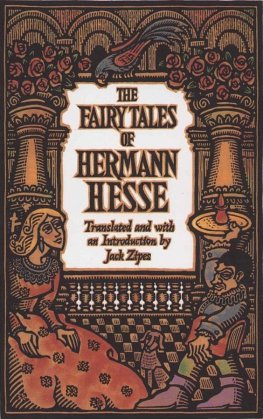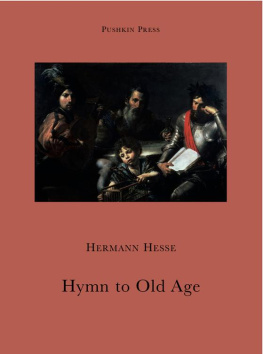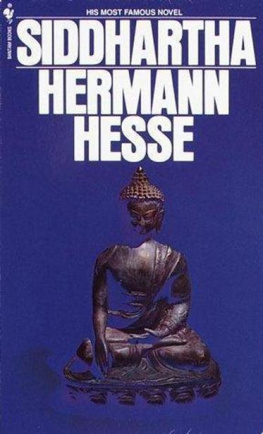Hermann Hesse - The Fairy Tales of Hermann Hesse
Here you can read online Hermann Hesse - The Fairy Tales of Hermann Hesse full text of the book (entire story) in english for free. Download pdf and epub, get meaning, cover and reviews about this ebook. year: 1995, publisher: Bantam Books, genre: Prose / Children. Description of the work, (preface) as well as reviews are available. Best literature library LitArk.com created for fans of good reading and offers a wide selection of genres:
Romance novel
Science fiction
Adventure
Detective
Science
History
Home and family
Prose
Art
Politics
Computer
Non-fiction
Religion
Business
Children
Humor
Choose a favorite category and find really read worthwhile books. Enjoy immersion in the world of imagination, feel the emotions of the characters or learn something new for yourself, make an fascinating discovery.
- Book:The Fairy Tales of Hermann Hesse
- Author:
- Publisher:Bantam Books
- Genre:
- Year:1995
- ISBN:9780553377767
- Rating:5 / 5
- Favourites:Add to favourites
- Your mark:
- 100
- 1
- 2
- 3
- 4
- 5
The Fairy Tales of Hermann Hesse: summary, description and annotation
We offer to read an annotation, description, summary or preface (depends on what the author of the book "The Fairy Tales of Hermann Hesse" wrote himself). If you haven't found the necessary information about the book — write in the comments, we will try to find it.
The Fairy Tales of Hermann Hesse — read online for free the complete book (whole text) full work
Below is the text of the book, divided by pages. System saving the place of the last page read, allows you to conveniently read the book "The Fairy Tales of Hermann Hesse" online for free, without having to search again every time where you left off. Put a bookmark, and you can go to the page where you finished reading at any time.
Font size:
Interval:
Bookmark:
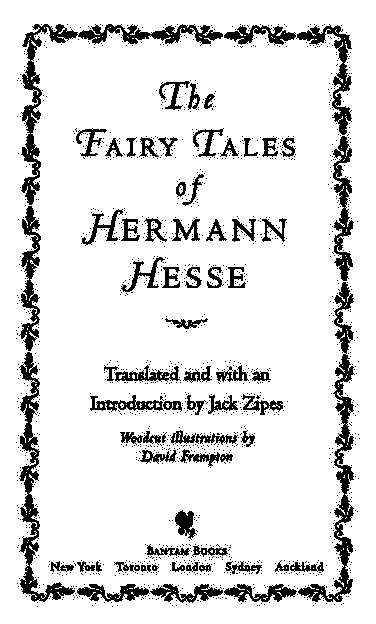
The Fairy Tales of Hermann Hesse
Hermann Hesses Fairy Tales and the Pursuit of Home
by Jack Zipes

Hermann Hesses fairy tales are not really fairy tales in the traditional sense of the term, and yet they are deeply embedded in both the Western and the Oriental traditions of fairy tales. Written between 1900 and 1933, Hesses unusual narratives record his endeavors to experiment with the fairy-tale genre and to make his own life as an artist into a fairy tale. He failed as far as his life was concerned because he could never achieve the ideal state he desired, but his tales were successful exactly because of this failure: They are filled with the inner turmoil of a writer desperately and seriously playing with aspects of a literary genre to find some semblance of peace and perfect harmony. To know Hermann Hesses fairy tales is to know the trauma, doubts, and dreams of the artist as a young man in Germany at the beginning of a tumultuous century. Like many other European writers, Hesse perceived the events around him the rapid advance of technology, the rise of materialism, the world wars, the revolutions, and the economic inflations and depressions as indicative of the decline of Western civilization. It was through art, especially the fairy tale, that Hesse sought to contend with what he perceived to be the sinister threat of science and commercialism.
Born in Calw, a small town in Swabia, on July 2, 1877, Hesse was raised in a religious household. His father, Johannes, who had been a pietistic missionary in India, continued to work in the ministry when he returned to Germany. His mother, Marie, was an assistant to her own father, Hermann Gundert, director of the Calw Publishing House, one of the leading pietistic book companies in Europe. Both parents were highly educated and totally dedicated to their religious beliefs, but they were not overly sectarian. Hesse found his pietistic home with its conservative routines to be oppressive, and early in his childhood he rebelled against the traditional ways of his parents and resisted authority of any kind. At one point in 1883, after his parents had moved to Basel, Switzerland, they gave serious thought to institutionalizing their son because he was so contrary, but fortunately for him he became more compliant and adjusted to the Swiss elementary school system. Three years later, in 1886, his parents returned to Germany to assume charge of the Calw Publishing House, and Hesse once again showed signs of rebelliousness. For the most part, however, he adhered to the pietistic principles of his parents and seemed prepared to pursue the highly regimented course of studies established in Germany.
In 1890 he was sent away to a private school in Gppingen, another small Swabian city, so that he could prepare for the entrance examinations required for admission to one of the Protestant schools in this region. Yet as soon as he started his studies at an exclusive academy in Maulbronn in 1892, he began suffering from headaches and insomnia and ran away from the school. His parents then sent him to an institution for mentally disturbed children, but Hesse continually resisted help from doctors and teachers as well as his parents, whom he thought had deserted him, and even contemplated suicide. For over a year, Hesse went in and out of different schools, homes, and sanatoriums, until his parents brought him back to Calw in October 1893.
During the next two years, he appeared to gain control over his moods. He helped his father at the Calw Publishing House, worked in the garden, and had brief apprenticeships in a bookstore and a clock factory. By this time, Hesse, who was an inveterate reader, was already writing poems and stories and wanted to dedicate himself to a literary career. However, his father refused to give him permission to leave home to try his luck as a writer. Then in October 1895 he was finally allowed to begin an apprenticeship as bookseller at the Heckenbauer Bookshop in Tbingen, a university city with a famous cultural tradition.
In Tbingen, free of family constraints and the pressure of formal schooling, Hesse began to sense the direction that he wanted his life to take as a writer. He formed important friendships with other young writers and underwent his own literary apprenticeship by reading medieval literature, the German romantics, and Oriental works. During this period he also published his first book of poems, Romantic Songs (Romantische Lieder, 1898), and his first book of short prose pieces, An Hour after Midnight (Eine Stunde hinter Mitternacht, 1899).
Most important, Hesse began to replace the Pietism of his parents with his own personal religion aestheticism. If there ever was a creed that he devoutly followed, it was the German romantic Novaliss notion that Mensch werden ist eine Kunstto become a human being is art. For Hesse, art the ultimate self-fulfillment meant connecting with a profound, essential feeling associated with home. But this home was not the home of his parents. Home was something intangible that was linked to aesthetic intuition and nurturing maternalism but was unique to each individual. It was both a return and a moving forward at the same time, and it could be attained only through art, through the artful formation of the self.
In 1899, Hesse accepted a position as an assistant bookseller in Reichs Bookshop in Basel, where he was to spend the next five years. Here he pursued his literary activities and made many new acquaintances, although he regarded himself more as an outsider and loner. In December 1900 he published The Posthumous Writings and Poems of Hermann Lauscher (Hinterlassene Schriften und Gedichte von Hermann Lauscher), which showed the strong influence of E.T.A. Hoffmann and other romantic writers. He continued writing poems and book reviews and in 1903 had his first major success with the publication of Peter Camenzind, a novel in which the young romantic protagonist eventually turns his back on the cosmopolitan world to dedicate himself to art. It was somewhat the opposite with Hesse, who at this point in his life was learning more and more to enjoy the company of literary circles. In 1904 he married Maria Bernoulli, a gifted photographer, and since he was now able to support himself through his writing, they moved to a farmhouse in a village called Gaienhofen near Lake Constance on the Swiss German border, where he and Maria hoped to be closer to nature and dedicate themselves to writing, painting, music, and photography. However, the period that Hesse spent in Gaienhofen, 19041912, was anything but idyllic.
To be sure, Hesse continued his prolific writing. He published Under the Wheel (Unterm Rad, 1904), an autobiographical novel about the brutality of educational institutions and authoritarianism in Germany; This Side (Diesseits, 1907) and Neighbors (Nachbarn, 1908), two collections of stories; Gertrud (1910), a novel; and Underway (Unterwegs, 1911), a volume of poems. He became an editor for an important cultural and political magazine, Mrz, founded in 1908, and wrote numerous reviews for various German newspapers and journals. He also became the father of three boys, Bruno in 1905, Heiner in 1909, and Martin in 1911; won literary prizes; and formed friendships with well-known musicians, artists, and writers. He was not happy in his marriage with Maria, however, who was nine years older than he was and too self-sufficient and independent for him. Within a short time after their move to Gaienhofen, they each began going their own way and soon had very little in common except for the children. Hesse felt more and more lonely and isolated in the country, and he often took trips by himself or traveled to give lectures. But leaving home only exacerbated his anguish and ennui. In efforts to assuage his discontent, he tried vegetarianism, painting, theosophy, and the religions of India. In 1911 he took a trip to Ceylon, Sumatra, and Malaya, hoping that he would find spiritual peace on the subcontinent. However, he never reached India because of dysentery and because he was upset by the poverty in Asia and the commercialization of Buddhism. He returned to Gaienhofen sick, exhausted, and still unhappy in his marriage. In another endeavor to change these conditions, he and Maria decided to move to Bern in 1912.
Next pageFont size:
Interval:
Bookmark:
Similar books «The Fairy Tales of Hermann Hesse»
Look at similar books to The Fairy Tales of Hermann Hesse. We have selected literature similar in name and meaning in the hope of providing readers with more options to find new, interesting, not yet read works.
Discussion, reviews of the book The Fairy Tales of Hermann Hesse and just readers' own opinions. Leave your comments, write what you think about the work, its meaning or the main characters. Specify what exactly you liked and what you didn't like, and why you think so.

